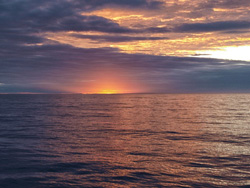Dr. Bill Williams, Institute of Ocean SciencesAugust 29, 2012Bill Williams, our Chief Scientist, gave a presentation to explain the science program aboard the Louis to the crew and scientists. Overall, the purpose of our science program is to monitor changes in the Beaufort Gyre of the Arctic Ocean. The Beaufort Gyre is a clockwise spinning oceanic gyre that is forced by clockwise wind and sea-ice motion rubbing against the ocean's surface. The forcing causes the fresh surface waters of the Arctic Ocean to flow towards the center of the Beaufort Gyre and accumulate there. [In the Arctic, this surface water is not very salty because there are large inputs of freshwater from the large North American and Siberian rivers that drain into the Arctic Ocean.] By returning each year, we obtain an annual summer 'snapshot' of this accumulation of freshwater and gradually build a long time series that allows us to see variations from one decade to the next and shifts in climate. We also deploy oceanographic moorings and install buoys in the sea ice, to obtain year-round data. These data allow us to observe the arctic seasons, such as the growth of ice during winter and its melt during summer, and to understand much more about the inner workings of the Beaufort Gyre. Summer sea-ice extent in the Arctic Ocean has reached record low levels: the current area of sea-ice was reported by NSIDC on 27 August to be 4.10 million km2 - below the 2007 record low of 4.17 million km2. Ice is currently continuing to melt at a rate of 75,000 km2 per day and is expected to reach a minimum that is significantly less than 2007 by mid-September. The most conspicuous new loss of Arctic sea-ice this summer is in the Canada Basin - the area of the Arctic Ocean north of Alaska and Canada. Old, perennial ice has persisted in the southern Canada Basin since 2007 preserving ice extent there each summer. This summer, however, the perennial ice is now missing and, for the first time, the ice edge has retreated to 75 North, the latitude of the McClure Strait entrance to the Northwest Passage. Since 2007, increases in the wind and ice motion have caused an increase in the amount of freshwater stored in the Beaufort Gyre so that the relatively-fresh surface layer is now thicker. This has had an interesting consequence for the ecosystem: In summer, the surface layer is depleted in the nutrients needed for phytoplankton (the plants of the ocean) to grow and typically we find these plankton living just underneath. Here there some nutrients in the water and some sunlight penetrates from the surface. Now that the nutrient-depleted surface waters are thicker, the phytoplankton must live deeper (to find food) which puts them further away from the sunlight (their source of energy). Thus conditions are now harsher for phytoplankton in the Beaufort Gyre and, because of this, we have found an increase in the smaller phytoplankton, which survive better than the larger ones in these conditions. (The Chief Scientist coordinates all the activities of our science teams with the Louis' Captain and crew. It's a job that requires a lot of conversation, as plans are made and problems solved.) Last updated: October 7, 2019 | |||||||||||||||||
Copyright ©2007 Woods Hole Oceanographic Institution, All Rights Reserved, Privacy Policy. | |||||||||||||||||



